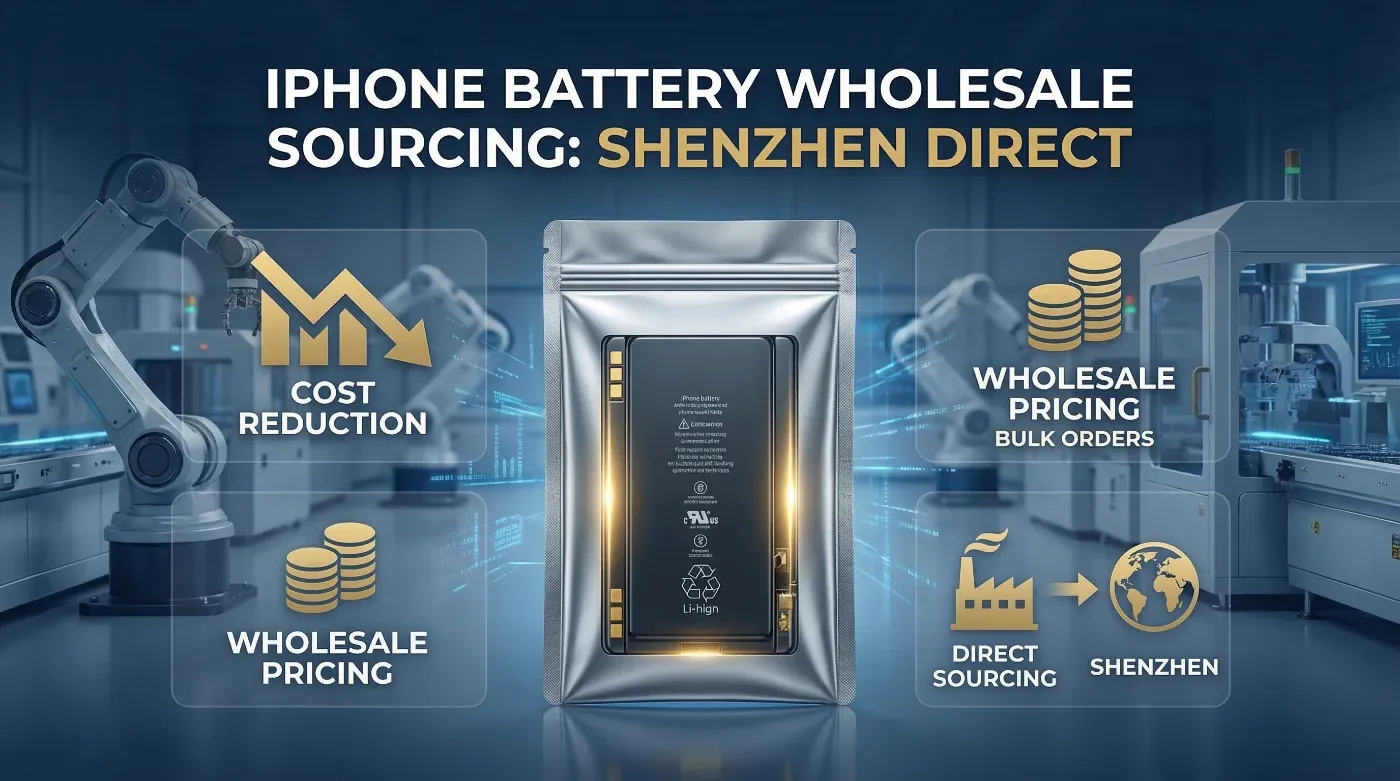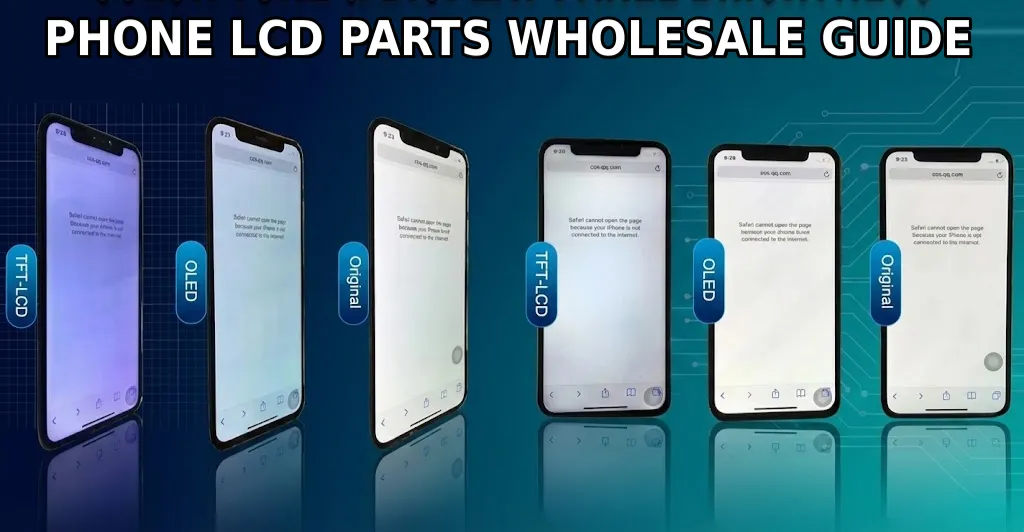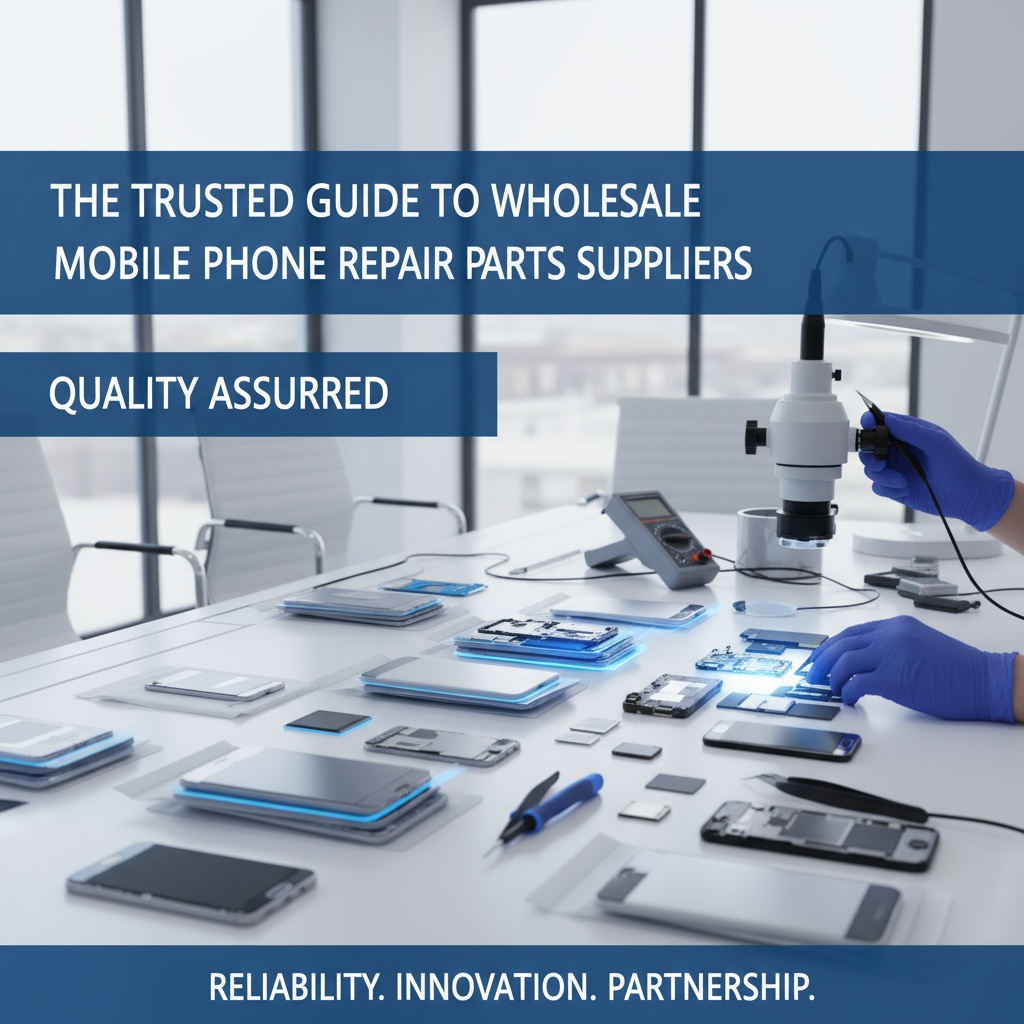Why Risk Your Business on Single-Source Display Suppliers?
Picture this: Your biggest client needs 500 iPhone 14 screens urgently, but your single supplier just informed you of a 6-week delay due to "supply chain disruptions." Meanwhile, your competitor secured the same order because they had diversified their mobile phone LCD factory partnerships. This scenario isn't hypothetical—it's happening right now across the repair industry as 2025's supply chain dynamics shift dramatically.
We've witnessed firsthand how businesses collapse when they rely on single-source suppliers, especially in today's volatile display panel market where geopolitical tensions and manufacturing disruptions can eliminate entire supply channels overnight.

Featured Snippet
The 2025 smartphone display aftermarket offers unprecedented supplier diversity, with Chinese panel makers now controlling 48% of global OLED production, creating multiple sourcing opportunities that smart buyers leverage to ensure consistent supply, competitive pricing, and comprehensive model coverage.

As supply chain professionals, we've analyzed the complete 2025 display supplier ecosystem to identify the most strategic sourcing opportunities. This comprehensive guide reveals how the landscape has fundamentally shifted, creating new possibilities for businesses willing to adapt their procurement strategies.
Table of Contents
- How Has the 2025 Display Supply Chain Actually Changed?
- Which LCD OEM Suppliers Can Really Deliver What They Promise?
- What Are the Hidden Risks Everyone Ignores When Sourcing?
- How Can Smart Buyers Turn Market Chaos Into Competitive Advantage?
How Has the 2025 Display Supply Chain Actually Changed? {#section1}
The smartphone display aftermarket has undergone a seismic transformation that most buyers haven't fully grasped. We're no longer dealing with the Samsung-LG duopoly that dominated previous years. Chinese manufacturers like BOE, CSOT, and Tianma have fundamentally altered the competitive landscape, creating opportunities that didn't exist just two years ago. Our analysis reveals that Apple alone now sources from multiple suppliers: Samsung Display supplied approximately 120 million screens, LG Display provided 62 million units, and BOE contributed 45 million displays in 2024. This multi-sourcing strategy by major OEMs has created parallel aftermarket opportunities that savvy buyers can exploit. The implications extend far beyond simple availability. When we examine the supplier matrix, we see that nearly every popular smartphone model now has at least one validated replacement source. However, the quality and availability tiers vary dramatically. High-volume models like iPhone 11 enjoy "high availability" with multiple aftermarket options, while cutting-edge flagships remain in "low availability" categories, typically limited to OEM-only sources. Chinese panel makers' 48% market share in global smartphone OLED production represents a paradigm shift. This isn't just about cost—it's about supply security. BOE alone produced 137 million smartphone OLEDs in 2024, while CSOT ramped up to become the exclusive supplier for devices like the Xiaomi 15S Pro. These volumes create inevitable spillover into aftermarket channels through various pathways.
| Supplier Category | Market Share 2025 | Aftermarket Availability | Key Advantages |
|---|---|---|---|
| Samsung Display | 35% | OEM-only, premium | Cutting-edge LTPO, foldables |
| Chinese Suppliers (BOE/CSOT/Tianma) | 48% | High availability | Cost-effective, diverse models |
| LG Display | 12% | Medium availability | Apple secondary source |
| Others (JDI, etc.) | 5% | Legacy models only | Declining relevance |
Quick Assessment:
- How many suppliers can currently provide screens for your top 3 selling phone models?
- Do you know which of your current suppliers use Chinese-manufactured panels?

Which LCD OEM Suppliers Can Really Deliver What They Promise? {#section2}
Not all display panel manufacturers are created equal, and the marketing promises often diverge sharply from operational reality. We've conducted extensive supplier capability assessments to separate genuine capacity from wishful thinking. The results reveal stark differences in reliability, quality consistency, and actual availability.
Samsung Display remains the gold standard for cutting-edge technology, particularly LTPO OLED and foldable displays. However, their aftermarket support is virtually non-existent—any Samsung panels in independent repair channels come through third-party redistribution with inherent supply uncertainties. Their monthly spare capacity for independent buyers is essentially zero, making them unsuitable for businesses requiring predictable procurement.
BOE presents a fascinating paradox in the supplier landscape. With massive production scale and broad model coverage, they offer excellent breadth for Chinese brand devices and growing presence in Apple's supply chain. However, their past quality issues and ongoing IP disputes with Samsung create legal risks that buyers must carefully consider. Our confidence rating for BOE is high for breadth but medium for consistency.
CSOT has emerged as a strategic alternative, particularly for businesses focused on Xiaomi and other Chinese brand repairs. Their exclusive supplier relationship with certain flagship models creates unique sourcing opportunities, though their limited exposure to Apple products restricts their utility for iOS-focused repair businesses.
Tianma deserves special recognition in the aftermarket ecosystem. They've become the de facto standard for iPhone LCD replacements, with their TFT panels forming the backbone of top-grade iPhone 6/7/8/11 replacement screens. Their model coverage is exceptionally high in the LCD domain, and they maintain large capacity for mid-tier OLED production.
| Supplier | Strengths | Gaps | Aftermarket KPI | Risk Factors |
|---|---|---|---|---|
| Samsung Display | Premium tech, reliability | No direct aftermarket support | Low availability | Single-source dependency |
| BOE | Massive scale, broad coverage | Quality inconsistency, IP disputes | High for Chinese brands | Legal/geopolitical risks |
| CSOT | Growing capacity, exclusive deals | Limited Apple exposure | High for Xiaomi | Tech limitations on ultra-high-end |
| Tianma | Aftermarket leader, LCD expertise | No Apple OLED supply | Very high for LCD/mid-tier | Chinese market dependency |
| LG Display | Apple secondary source | Smaller OLED volume | Medium for Apple models | Limited model coverage |
Reality Check Questions:
- Can your current suppliers provide certificates of origin for their panels?
- What's your backup plan if your primary supplier faces IP litigation?

What Are the Hidden Risks Everyone Ignores When Sourcing? {#section3}
The display sourcing landscape is riddled with hidden risks that can devastate unprepared businesses. We've identified critical risk categories that most buyers completely overlook until it's too late. Understanding these risks isn't just about compliance—it's about business survival in an increasingly complex regulatory environment.
Intellectual property constraints represent perhaps the most underestimated threat. Samsung's ITC complaint against BOE for OLED patent infringement could potentially result in a 15-year US import ban on certain BOE panels. Such legal actions can instantly eliminate entire supplier relationships and strand businesses with unusable inventory. The gray-market nature of many aftermarket parts amplifies these risks significantly.
Geopolitical tensions create another layer of vulnerability. The concentration of display manufacturing in East Asia, particularly China, exposes buyers to sudden supply disruptions from trade wars, sanctions, or diplomatic conflicts. We've already seen how the Samsung-BOE corporate fallout eliminated BOE's supply to Samsung from 1.1 million units in 2022 to zero by 2024, forcing rapid supplier substitutions.
Quality and warranty risks vary dramatically across supplier tiers and regions. Our analysis shows that OEM parts typically have less than 2% DOA rates, while even premium aftermarket copies might experience 5% field return rates. More concerning are the batch variability issues—one production run might perform excellently while the next exhibits higher failure rates due to material or process variations.
The regulatory landscape continues evolving, with Europe's Right-to-Repair directives mandating 5-year spare parts availability at "reasonable" prices. While this improves official availability, it doesn't necessarily reduce costs or friction for independent procurement. Meanwhile, anti-repair measures like parts pairing increasingly limit aftermarket compatibility, potentially making entire categories of replacement parts obsolete overnight.
| Risk Category | Probability | Impact | Mitigation Strategy |
|---|---|---|---|
| IP Litigation | Medium | Severe | Multi-source suppliers, legal compliance |
| Geopolitical Disruption | Medium | Severe | Geographic diversification |
| Quality Variability | High | Medium | Batch testing, supplier audits |
| Regulatory Changes | High | Medium | Compliance monitoring, legal partnerships |
| Parts Pairing/DRM | High | High | Technical workarounds, certified tools |
Risk Assessment Exercise:
- What percentage of your supply chain originates from a single country?
- Do you have written IP compliance procedures for aftermarket parts?

How Can Smart Buyers Turn Market Chaos Into Competitive Advantage? {#section4}
The current market volatility, while challenging, creates unprecedented opportunities for strategically-minded buyers. We've developed proven methodologies that transform supply chain complexity into sustainable competitive advantages. The key lies in understanding how to leverage supplier diversity, pricing inefficiencies, and market timing to build resilient procurement operations.
Multi-sourcing strategies have become essential rather than optional. Our recommended approach involves maintaining both OEM and top-tier aftermarket sources for popular models, creating natural hedges against cost and supply risks. For instance, securing both Samsung OEM and premium copy sources for iPhone screens provides flexibility to optimize for either cost or quality depending on customer requirements and market conditions.
Pricing arbitrage opportunities abound in the current fragmented market. Regional price variations show China offering baseline pricing, while US/EU markets trade at approximately 1.3x multiples for most components. Middle Eastern hubs like Dubai provide intermediate pricing at roughly 1.1x China costs, creating strategic importing opportunities for businesses willing to manage additional logistics complexity.
The refurbishment economics deserve special attention as a source of competitive advantage. High-quality refurbished screens typically sell at 50-70% of new OEM prices while maintaining near-original performance characteristics. Yield rates for flat OLED refurbishment reach 80%, making this a substantial profit opportunity for buyers who can establish reliable refurbishment partnerships.
Strategic inventory management becomes crucial in this environment. Building selective stockpiles of critical screens—particularly for single-source models—provides insurance against sudden supply disruptions. However, this must be balanced against working capital costs and technology obsolescence risks as new models launch continuously.
| Strategy Element | Implementation | Expected Benefit | Resource Requirement |
|---|---|---|---|
| Multi-source partnerships | 2-3 suppliers per major model | 30-40% cost flexibility | Medium setup, low maintenance |
| Regional arbitrage | Direct China sourcing + redistribution | 20-30% cost savings | High logistics, medium risk |
| Refurbishment integration | Partner with certified refurbishers | 25-35% margin improvement | Medium technical, medium risk |
| Strategic inventory | 30-60 day buffer on critical models | Supply continuity assurance | High working capital |
Action Planning Questions:
- Which three models represent your highest-volume, highest-margin opportunities?
- How quickly can you pivot suppliers if your primary source fails?

Essential Tools and Resources for Display Sourcing Success
Navigating the complex display sourcing landscape requires the right tools and partnerships. We've curated the most effective resources that consistently deliver results for serious buyers in this market. These aren't theoretical recommendations—they're battle-tested tools that we use daily in our own sourcing operations.
Professional sourcing platforms extend far beyond basic marketplace browsing. Alibaba's Trade Assurance program provides payment protection and supplier verification, while GlobalSources offers more curated supplier relationships with enhanced due diligence. However, the real value lies in establishing direct relationships with major distributors like Guangzhou Focus and Best Partner, who aggregate panels from multiple factories while providing quality assurance and warranty coverage.
| Tool/Platform | Primary Use | Cost Structure | Reliability Rating |
|---|---|---|---|
| Alibaba Trade Assurance | Bulk sourcing, payment protection | Free platform, transaction fees | High for verified suppliers |
| GlobalSources | Curated supplier network | Subscription + transaction fees | Very high |
| Guangzhou Focus | Direct distributor relationships | Negotiated terms | Excellent |
| iFixit Partner Program | OEM parts access | Volume-based pricing | High for certified parts |
| REWA Technology | Technical tools and parts | Equipment + parts cost | Excellent for repair tools |
 |
Conclusion: Your Next Strategic Moves
The 2025 smartphone display aftermarket represents both unprecedented opportunity and substantial risk. Success requires abandoning outdated single-source strategies in favor of sophisticated multi-sourcing approaches that leverage the new supplier diversity while managing inherent risks through careful partner selection and strategic planning.
Three Critical Actions for Immediate Implementation: • Diversify your supplier base immediately - Establish relationships with at least two suppliers for your top-selling models, balancing OEM and aftermarket sources to optimize for both cost and quality flexibility. • Implement comprehensive risk management protocols - Develop written IP compliance procedures, establish geographic supplier diversity, and create buffer inventory for critical single-source components. • Leverage pricing inefficiencies strategically - Explore direct China sourcing relationships and refurbishment partnerships to capture margin improvements while maintaining quality standards through rigorous testing and supplier audits.
The businesses that thrive in this new environment will be those that treat sourcing as a strategic competency rather than a tactical purchasing function. The data and frameworks provided in this analysis give you the foundation—but success depends on execution speed and consistency.

Further Reading and Industry Resources
For continued learning and market intelligence, we recommend these authoritative sources: • DSCC Display Supply Chain Reports - Quarterly market analysis and supplier intelligence • OLED-Info Industry Database - Technical developments and supplier news • TrendForce Display Research - Production forecasts and pricing analysis • Display Daily News - Daily industry updates and strategic commentary • Omdia Display Intelligence - Comprehensive market research and forecasts
Ready to transform your display sourcing strategy? Our comprehensive supplier database and risk management frameworks can help you navigate this complex landscape with confidence. Request a Quote to discuss your specific requirements and discover how our low MOQ, comprehensive model coverage, and fast shipping capabilities can strengthen your competitive position in 2025's dynamic market.




